Heriot-Watt University
| Heriot-Watt University | |
|
Leaders in ideas and solutions | |
|---|---|
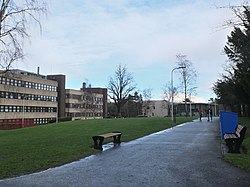
| |
 | |
| Founded: | 1821 |
| Chancellor: | Robert M Buchan |
| Type: | Suburban |
| Endowment: | £8.9 million (2017) |
| Website: | www.hw.ac.uk |
| Location | |
| Grid reference: | NT175695 |
| Location: | 55°54’41"N, 3°19’17"W |
Heriot-Watt University a is a public research university based in Edinburgh, Midlothian. It was established in 1821 as the School of Arts of Edinburgh, the world's first mechanics' institute, and subsequently granted university status by royal charter in 1966. It is the eighth-oldest higher education institute in the UK. The name Heriot-Watt was taken from the engineeer and inventor James Watt and the philanthropist and goldsmith George Heriot.
Known for its focus on science and engineering, Herio Watt is one of the 39 old universities in the United Kingdom, comprising the second cluster of elite universities after Oxbridge.[1]
History
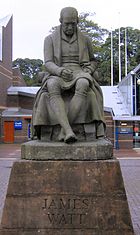
School of Arts of Edinburgh
Heriot-Watt was established as the School of Arts of Edinburgh by Leonard Horner, a businessman, on 16 October 1821. Having been inspired by Anderson's College in Glasgow, Horner established the School to provide practical knowledge of science and technology to Edinburgh's working men.[2] The institution was initially of modest size, giving lectures two nights a week in rented rooms[3] and holding a small library of around 500 technical works.[2] It was also oversubscribed, with admissions soon closing despite the cost of 15 shillings for a year's access to lectures and the library.[2]
The School was managed by a board of eighteen directors[2] and primarily funded by sponsors from the middle and upper classes including Robert Stevenson and Walter Scott. It first became associated with the inventor and engineer James Watt in 1824, as a means of raising funds to secure permanent accommodation. Justifying the association, School Director Lord Cockburn said:
"[The building] shall be employed for the accommodation of the Edinburgh School of Arts; whereby the memory of Watt may forever be connected with the promotion, among a class of men to which he himself originally belonged, of those mechanical arts from which his own usefulness and glory arose."
In 1837, the School of Arts moved to leased accommodation on Adam Square, which it was able to purchase in 1851 thanks to funds raised in Watt's name. In honour of the purchase, the School changed its name to the Watt Institution and School of Arts in 1852.
Watt Institution and School of Arts
Heriot-Watt's time as the Watt Institution marked a transitional period for the organisation, as its curriculum broadened to include several subjects beyond mathematics and the physical sciences. While the School of Arts had catered almost exclusively to working-class artisans and technical workers, the Watt Institution admitted a large number of middle-class students, whom it attracted with new subjects in the sciences, social sciences and humanities. By 1885, the skilled working class were no longer the majority in an institution that had been created explicitly for them.
A shifting class make-up was not the only demographic change to affect the student body, as in 1869 women were permitted to attend lectures for the first time. This move put the Watt Institution some way ahead of Scottish universities, who were only permitted to allow women to graduate 20 years later following the Universities (Scotland) Act of 1889.[4]:163 The decision to admit women was made in large part owing to pressure from local campaigner Mary Burton, who later became the Institution's first female director in 1874.[5]
In 1870, the Watt Institution was forced to move following the demolition of Adam Square. After a brief period on Roxburgh Place, it relocated to the newly constructed Chambers Street near where its former site had stood. The move caused the Institution severe financial difficulties, which were compounded by a combination of declining funds from subscribers and increased costs from its growing student body. In 1873, the Directors turned to George Heriot's Trust for support, and agreed to a merger of the Trust's endowment with the Institution's own. The proposed merger was provisional to changes in the structure of the Watt Institution, which would see the organisation become a technical college with representatives of the Trust in management positions. Accepting these changes, the Watt Institution officially became Heriot-Watt College in 1885, and was subsequently on far firmer financial ground.
The Watt Club
The Watt Club was founded at the Watt Institution on 12 May 1854, and is today the oldest alumni organisation in the United Kingdom. Following the unveiling of a statue of James Watt outside the Institution, local jeweller J.E Vernon proposed that
"[a club should be formed] whose object would be to sup together on the anniversary of the birth of James Watt…and also to promote the interests of the School, by raising a fund each year to provide prizes."
Watt Club Medals are still awarded by the organisation each year to Heriot-Watt's most highly achieving students, while the Watt Club Prize is awarded by The Watt Club Council to recognise student initiative and enterprise.[6]
Heriot-Watt College
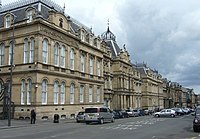
After the establishment of Heriot-Watt as a technical college, the new management committee set about extending the institution's buildings and strengthening its academic reputation. In its new form the college was one of only three non-university institutions in the United Kingdom with the power to appoint professors, and the first of these was appointed in 1887. In 1902 the College became a central institution, while in 1904 it introduced awards for graduating students which were similar to university degrees.
Expansion meant that the college made increasing demands on George Heriot's Trust throughout the first part of the 20th century, which ultimately led to the independence of the two bodies in 1927. While the Trust continued to pay Heriot-Watt a fixed sum each year, from then on the college was responsible for managing its own financial affairs. Heriot-Watt continued to expand after becoming independent, opening a new extension in 1935.
Both World Wars impacted on the speed of the college's expansion. During First World War, student numbers dropped as young men joined the army, while teaching in engineering stalled as the department was used for the manufacture of shells and munitions. During Second World War, student numbers dropped again and the electrical engineering department became involved in training the armed services in the use of radar.
After the College introduced a postgraduate award in 1951, it offered awards equivalent to university degrees and doctorates in all practical respects. Recognising this, in 1963 the Robbins Report recommended that it should be awarded university status. On 1 February 1966 the recommendation was enacted, as the institution officially became Heriot-Watt University.
Heriot-Watt University
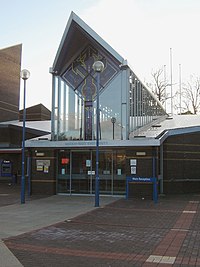
The first personal chair was appointed in 1974.[7]
While Heriot-Watt continued to expand in the centre of Edinburgh after attaining university status, the institution had grown big enough that relocation was felt to be desirable. In 1966 Midlothian County Council gifted the Riccarton estate north of Currie to the University and in 1969 work began on transforming the site into a future campus. The process of relocation to Riccarton continued until 1992, with teaching and facilities divided between the new campus and the city centre until this time.
The University has continued to grow after completing its move to Riccarton, constructing additional student halls, a sports centre and a postgraduate centre on the site. The institution also expanded beyond Edinburgh, merging with the Scottish College of Textiles to create a campus in Selkirkshire in 1998, opening a campus in Dubai in 2006 and a campus in Putrajaya, Malaysia, in 2012.[8]
Campuses
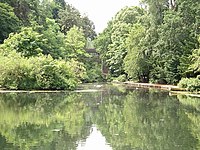
Heriot-Watt currently has five campuses, and also runs distance learning programmes:
- Edinburgh, the main campus
- Galashiels in Selkirkshire, home to the University's School of Textile and Design
- Stromness in Orkney, home to the International Centre for Island Technology, part of the University's School of Energy, Geoscience, Infrastructure and Society.
- Dubai
- Malaysia
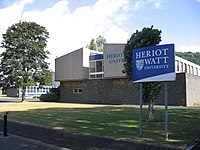
Outside links
| ("Wikimedia Commons" has material about University Heriot-Watt University) |
- Heriot-Watt University
- Heriot-Watt University Students Union
- Heriot-Watt University Dubai
- Heriot-Watt University Malaysia
References
- ↑ Boliver, Vikki (2015). "Are there distinctive clusters of higher and lower status universities in the UK?". Oxford Review of Education 41 (5): 608–627. doi:10.1080/03054985.2015.1082905. http://dro.dur.ac.uk/14978/1/14978.pdf.
- ↑ 2.0 2.1 2.2 2.3 Jameson, R (1824), "Some Account of the School of Arts of Edinburgh.", The Edinburgh Philosophical Journal 11: 203–205, https://books.google.com/books?id=qzowAAAAYAAJ&q=%22school+of+arts+of+edinburgh%22&pg=PA203
- ↑ "GASHE: School of Arts, Edinburgh.". http://www.gashe.ac.uk:443/isaar/C1239.html.
- ↑ Barnett, H. (2011). Constitutional & Administrative Law (8th Edition). Routledge. ISBN 978-0415578813
- ↑ "Gazetteer for Scotland: Mary Burton.". http://www.scottish-places.info/people/famousfirst3796.html.
- ↑ "Heriot-Watt Academic Registry: Prizes and Awards.". https://www.hw.ac.uk/students/studies/student-record.htm.
- ↑ "Heriot Watt's new professor". The Glasgow Herald: p. 11. 29 June 1974. https://news.google.com/newspapers?id=huc9AAAAIBAJ&pg=1874%2C5720115.
- ↑ "Heriot-Watt University: Official Opening of Heriot-Watt University Malaysia.". https://www.hw.ac.uk/about/news/archive/official-opening-heriot-watt-university-malaysia.htm.
